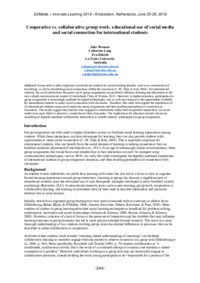Cooperative vs collaborative group workeducational use of social media and social connection for international students
Zu finden in: EdMedia 2018, 2018
|
 |
 Diese Seite wurde seit 6 Jahren inhaltlich nicht mehr aktualisiert.
Unter Umständen ist sie nicht mehr aktuell.
Diese Seite wurde seit 6 Jahren inhaltlich nicht mehr aktualisiert.
Unter Umständen ist sie nicht mehr aktuell.
 Zusammenfassungen
Zusammenfassungen
Group work is often employed in educational contexts for social learning benefits, such as co-construction of knowledge, as well as facilitating social connections within the classroom (C-M Zhao & Kuh, 2004) For international students, the social interactions that grow out of group assignments can positively influence learning and adjustment to the new cultural and educational context (Cruickshank, Chen, & Warren, 2012) However, in higher education, participation in group assignments is increasingly mediated by digital technologies, and as such may impact on the opportunities available for international students to make social connections with classmates Therefore, this study investigated the experiences of 26 international students using social media for group assignments and their resulting perceptions of connection to classmates The results suggest that students who engaged in collaborative rather than cooperative interactions via social media were more likely to perceive a connection to their classmates The implications for educators include classroom modelling of digitally-mediated collaborative interactions to benefit students’ participation in group assignments
Von Jade Sleeman, Catherine Lang, Eva Dakich im Konferenz-Band EdMedia 2018 (2018) im Text Cooperative vs collaborative group work  Volltext dieses Dokuments
Volltext dieses Dokuments
 |  Cooperative vs collaborative group work: educational use of social media and social connection for international students: Volltext als PDF ( Cooperative vs collaborative group work: educational use of social media and social connection for international students: Volltext als PDF ( : :  , 169 kByte; , 169 kByte;  : :  2021-03-21) 2021-03-21) |
 Anderswo suchen
Anderswo suchen 
 Beat und dieses Konferenz-Paper
Beat und dieses Konferenz-Paper
Beat hat Dieses Konferenz-Paper während seiner Zeit am Institut für Medien und Schule (IMS) ins Biblionetz aufgenommen. Er hat Dieses Konferenz-Paper einmalig erfasst und bisher nicht mehr bearbeitet. Beat besitzt kein physisches, aber ein digitales Exemplar. Eine digitale Version ist auf dem Internet verfügbar (s.o.). Aufgrund der wenigen Einträge im Biblionetz scheint er es nicht wirklich gelesen zu haben. Es gibt bisher auch nur wenige Objekte im Biblionetz, die dieses Werk zitieren.











 Biblionetz-History
Biblionetz-History